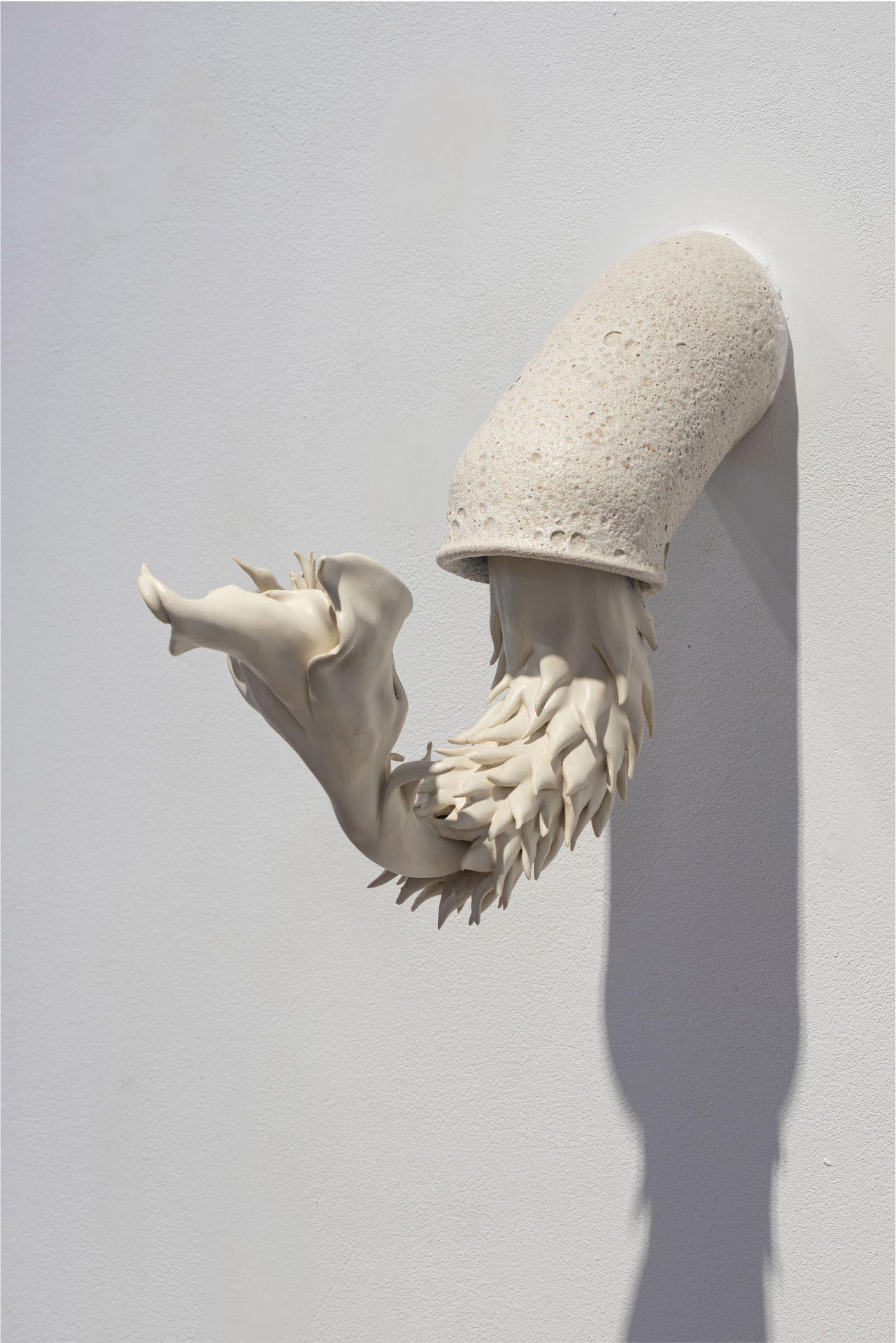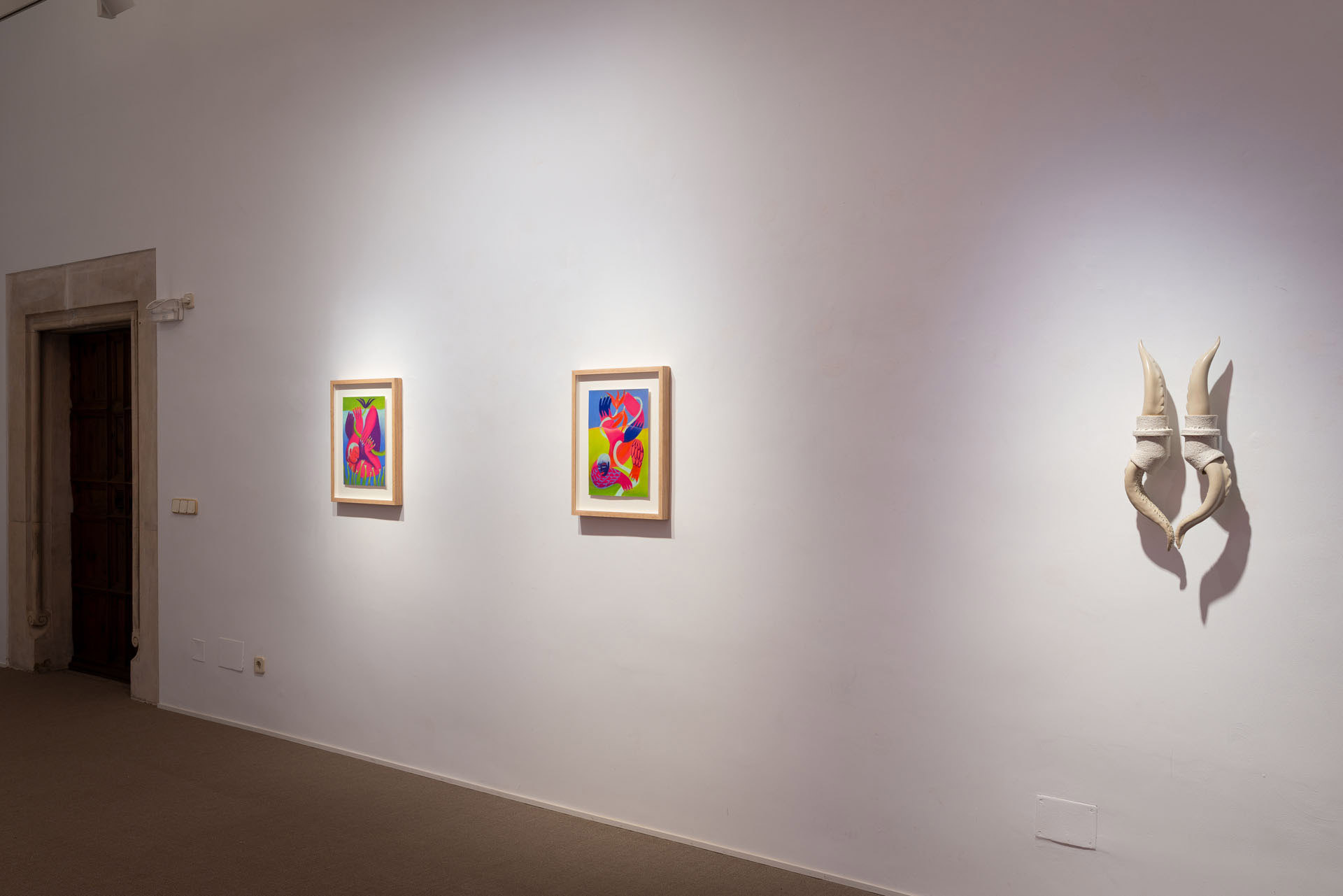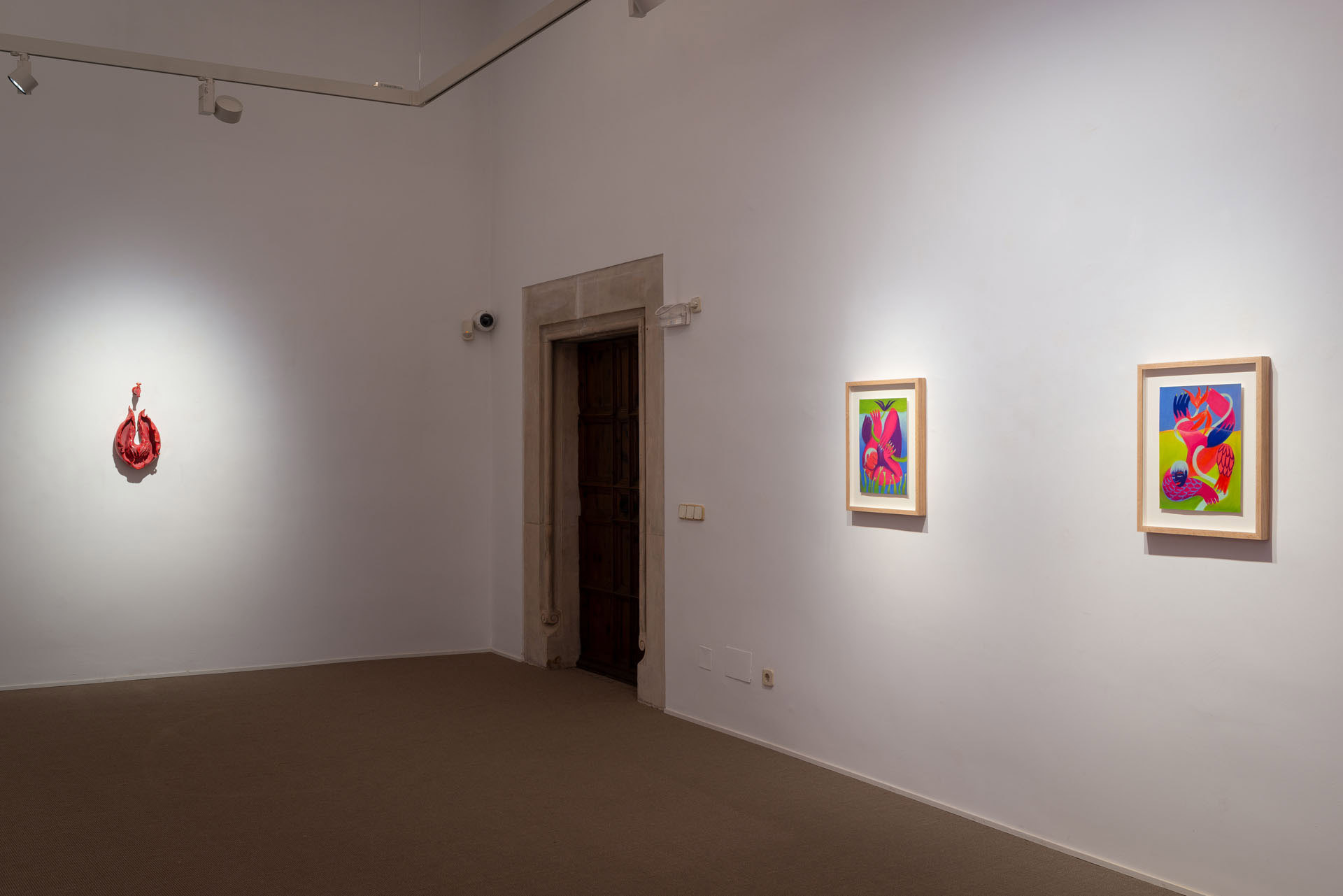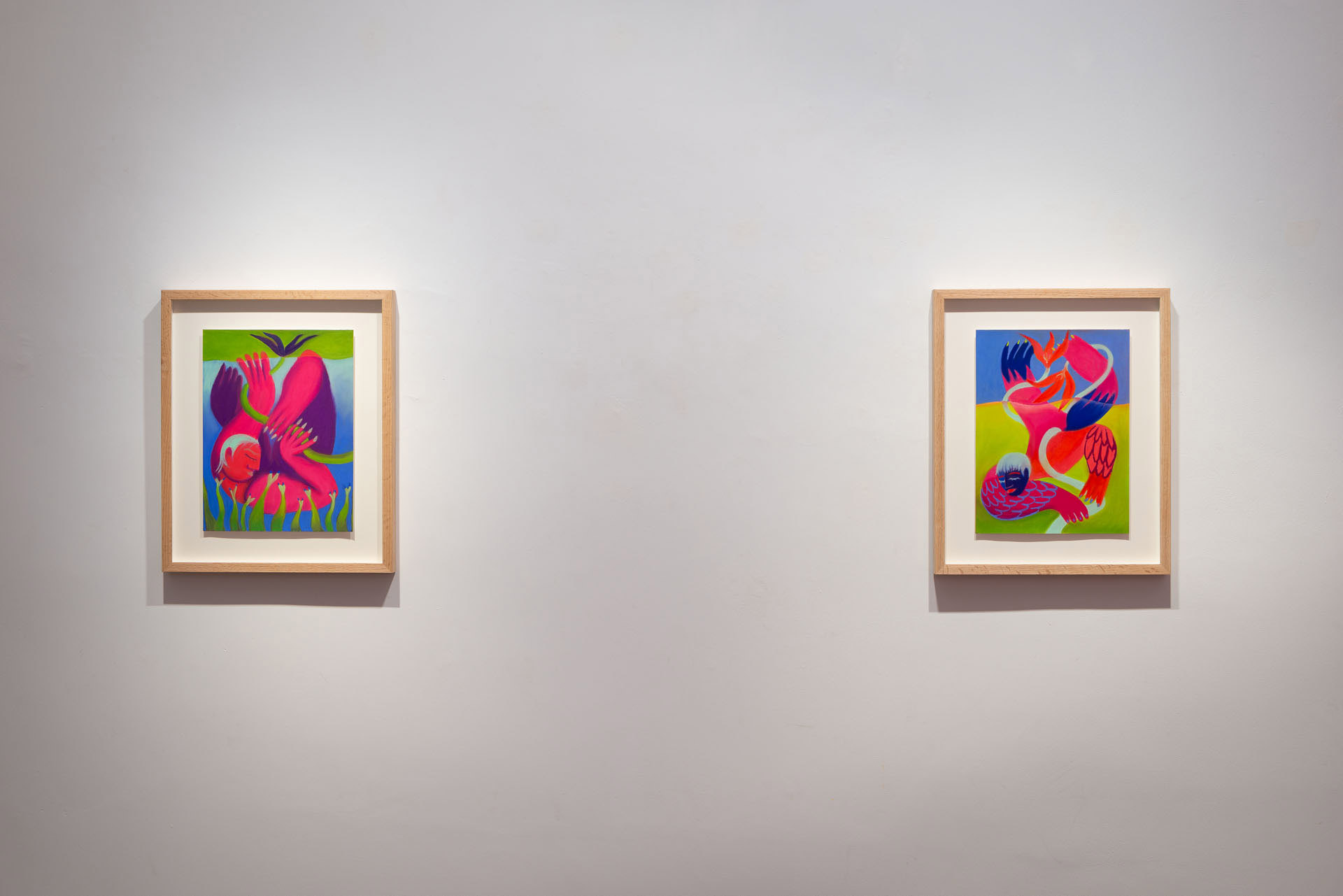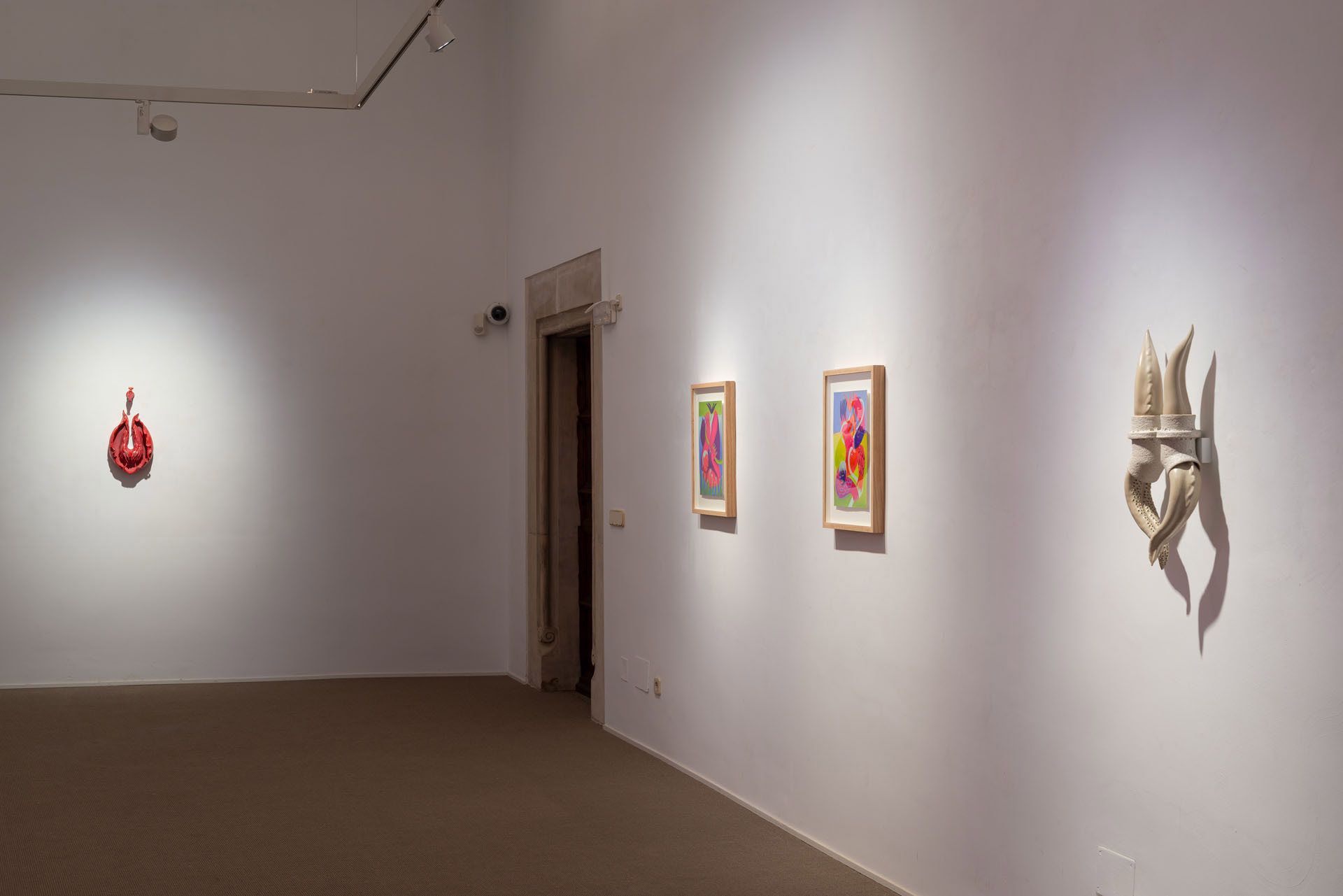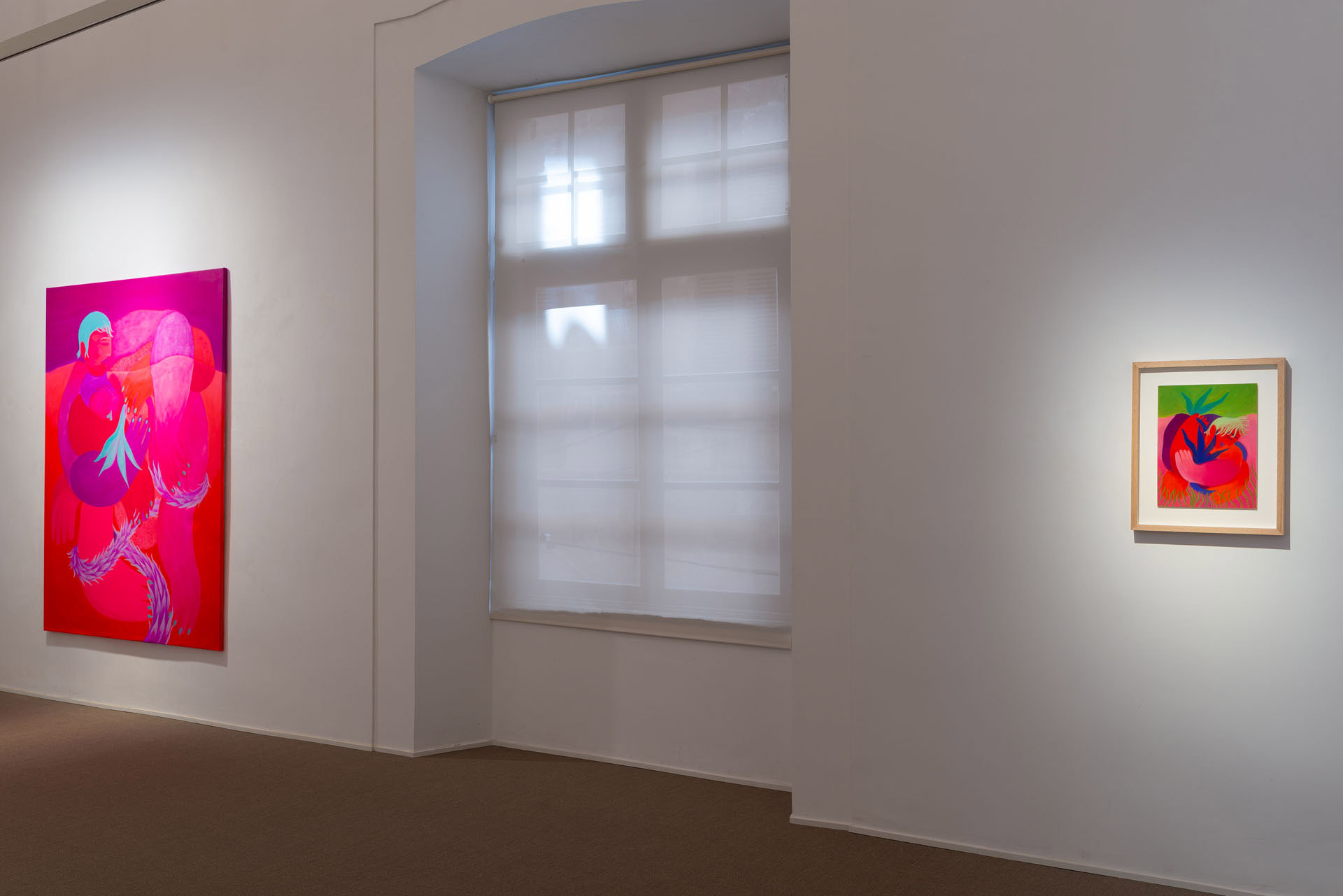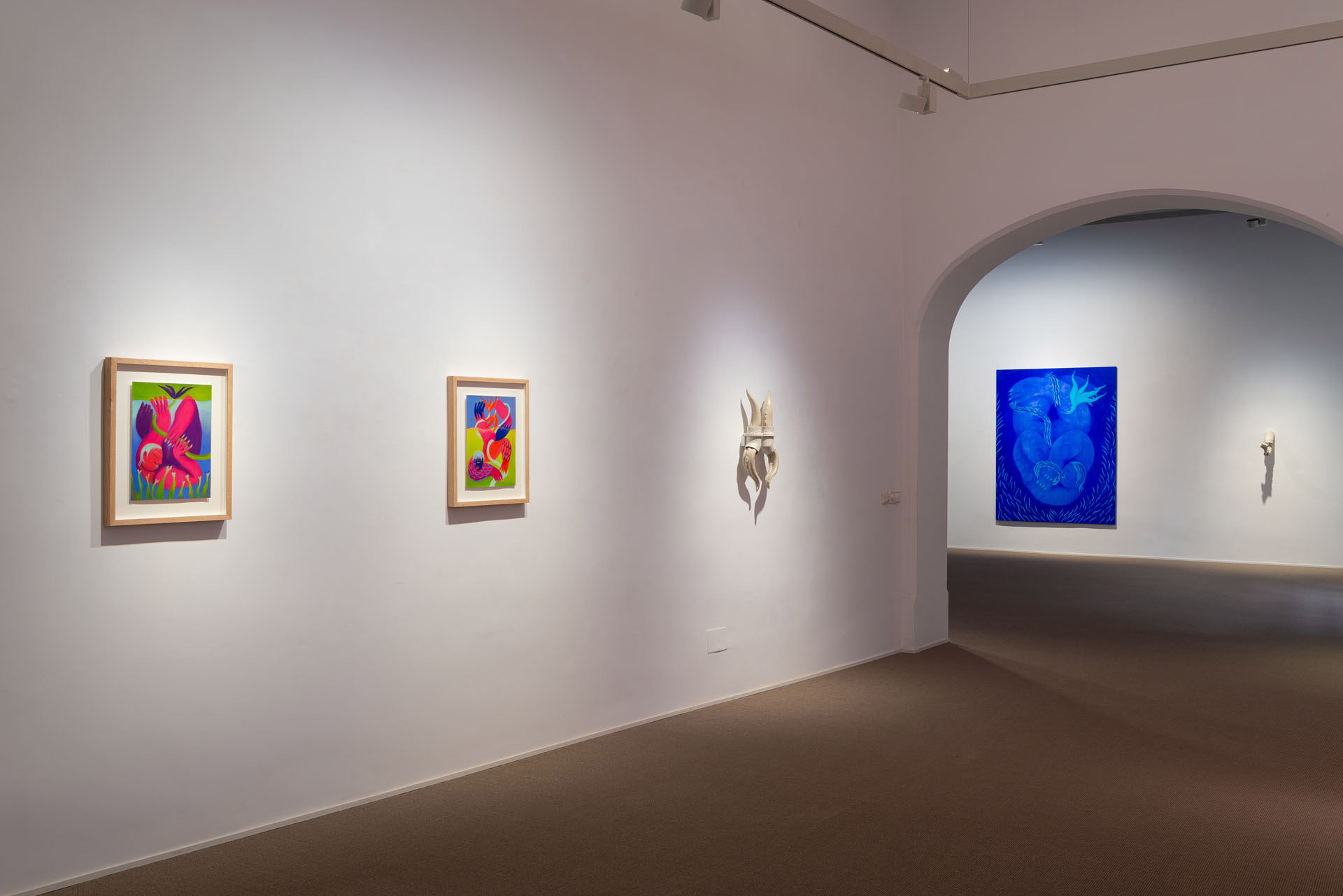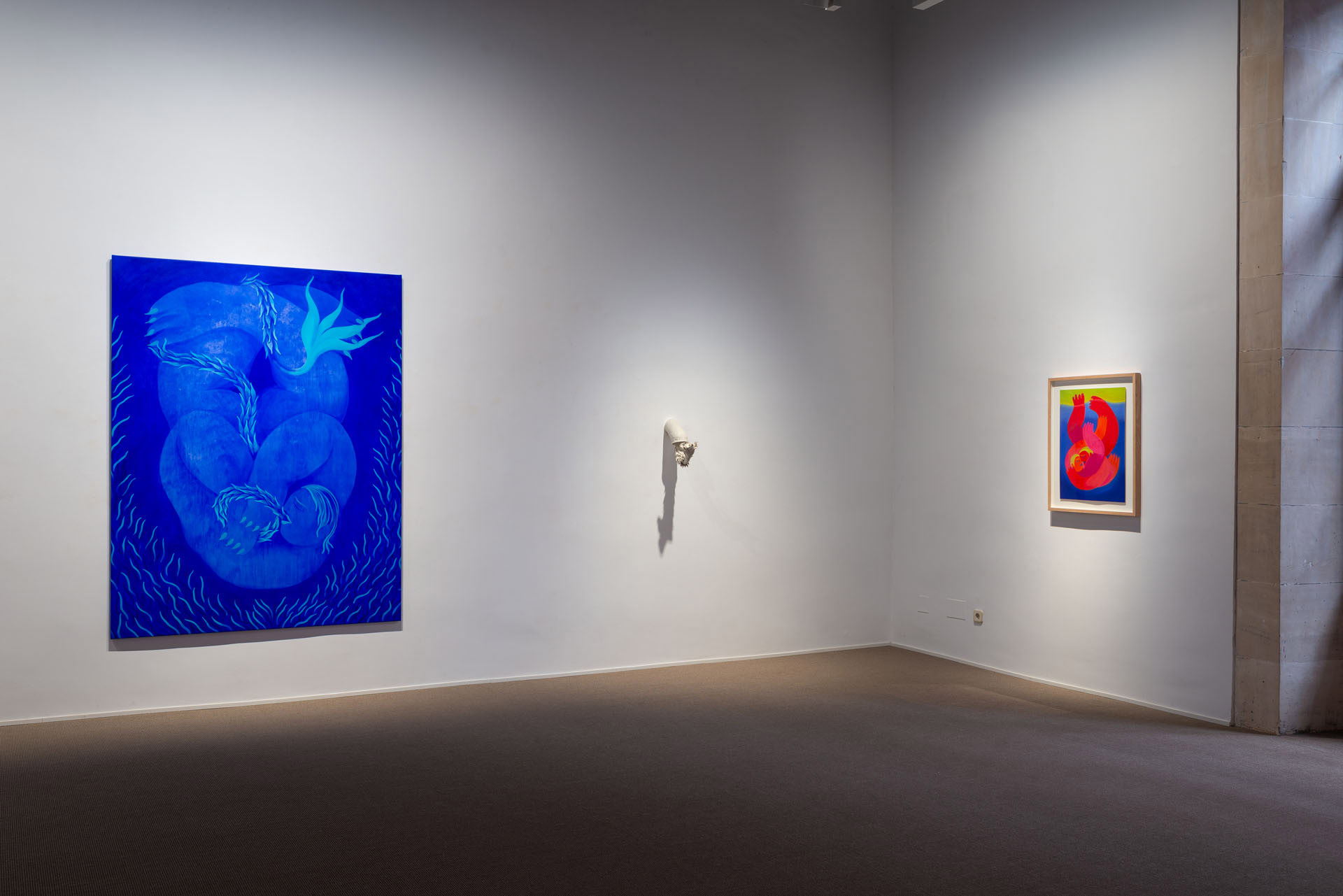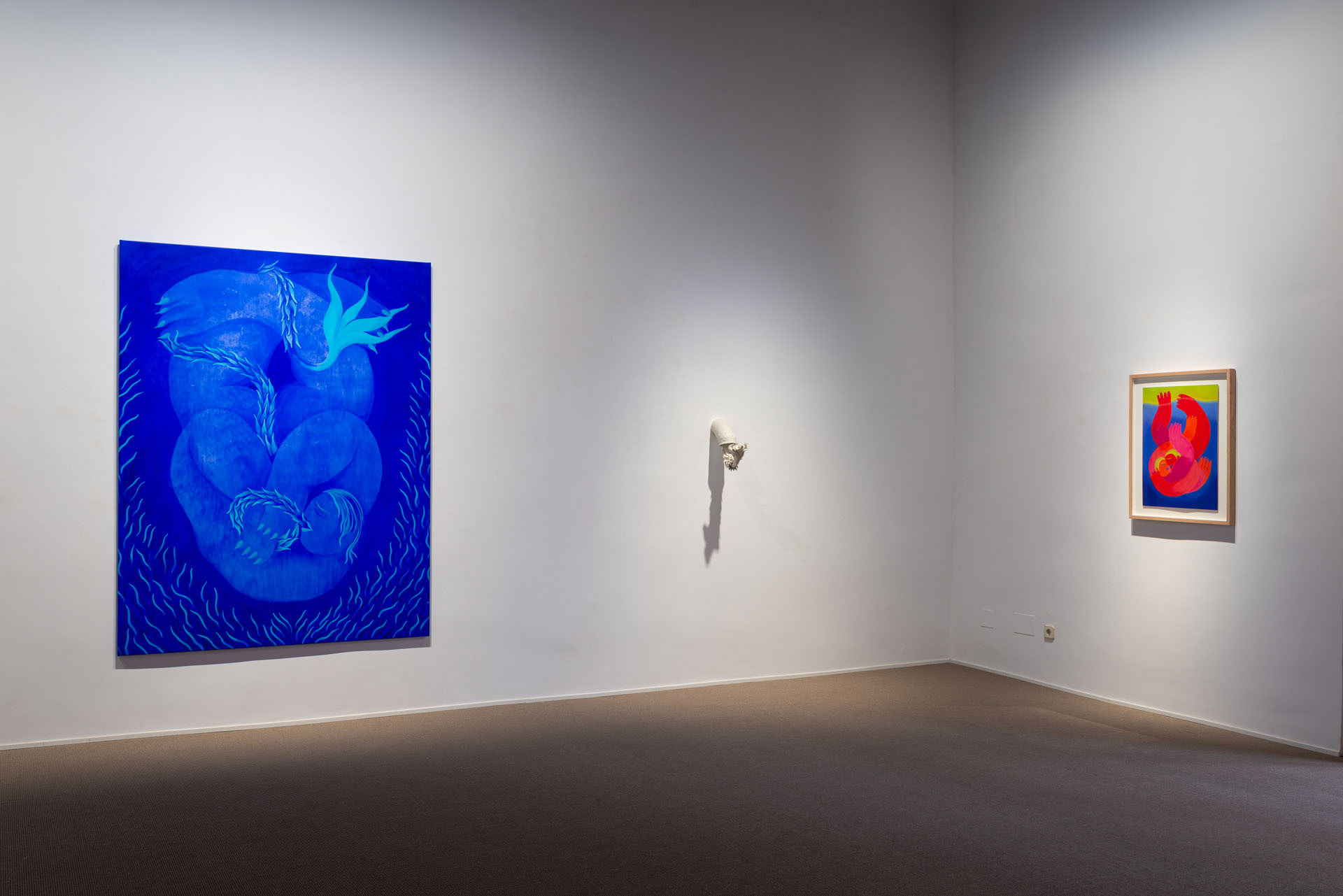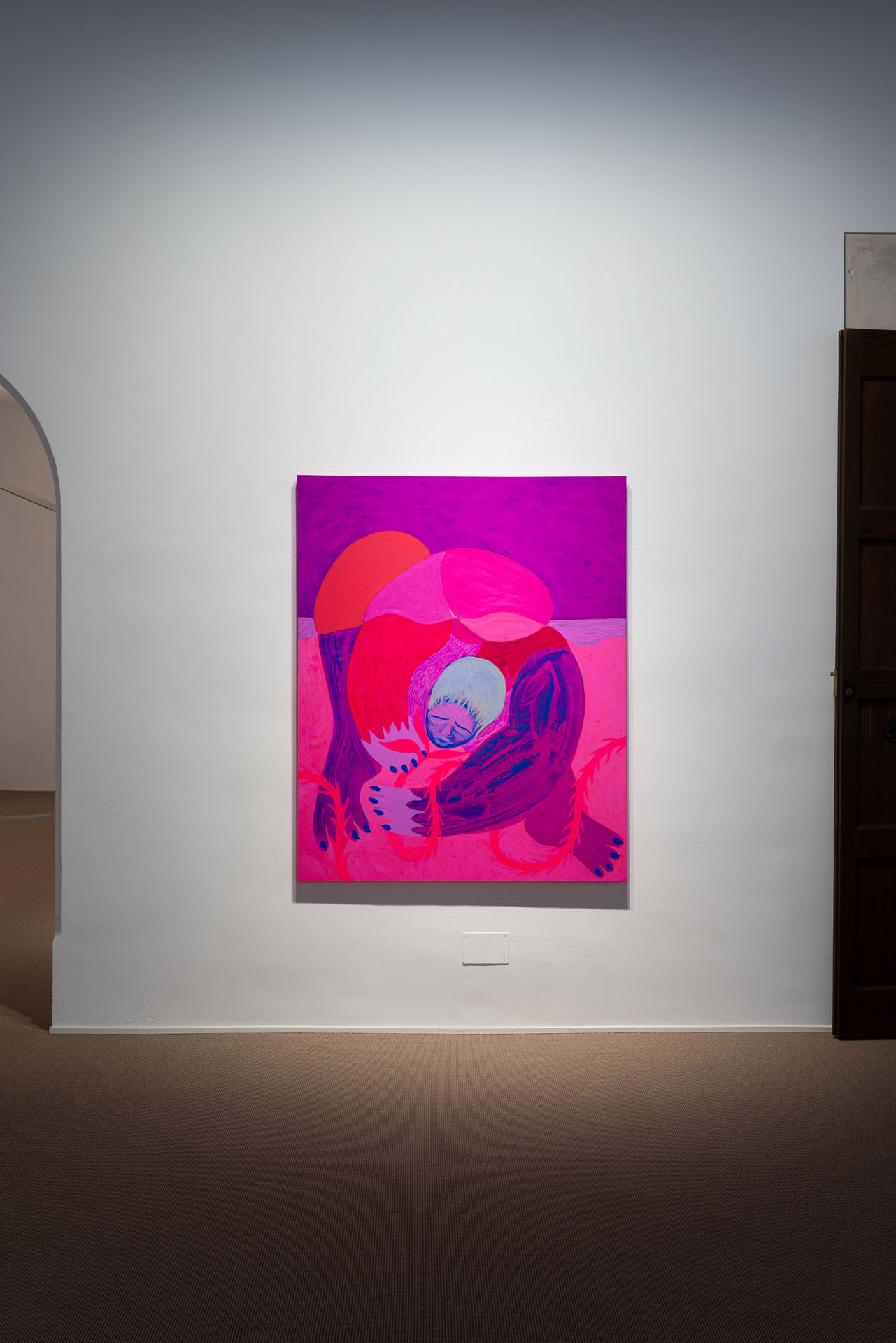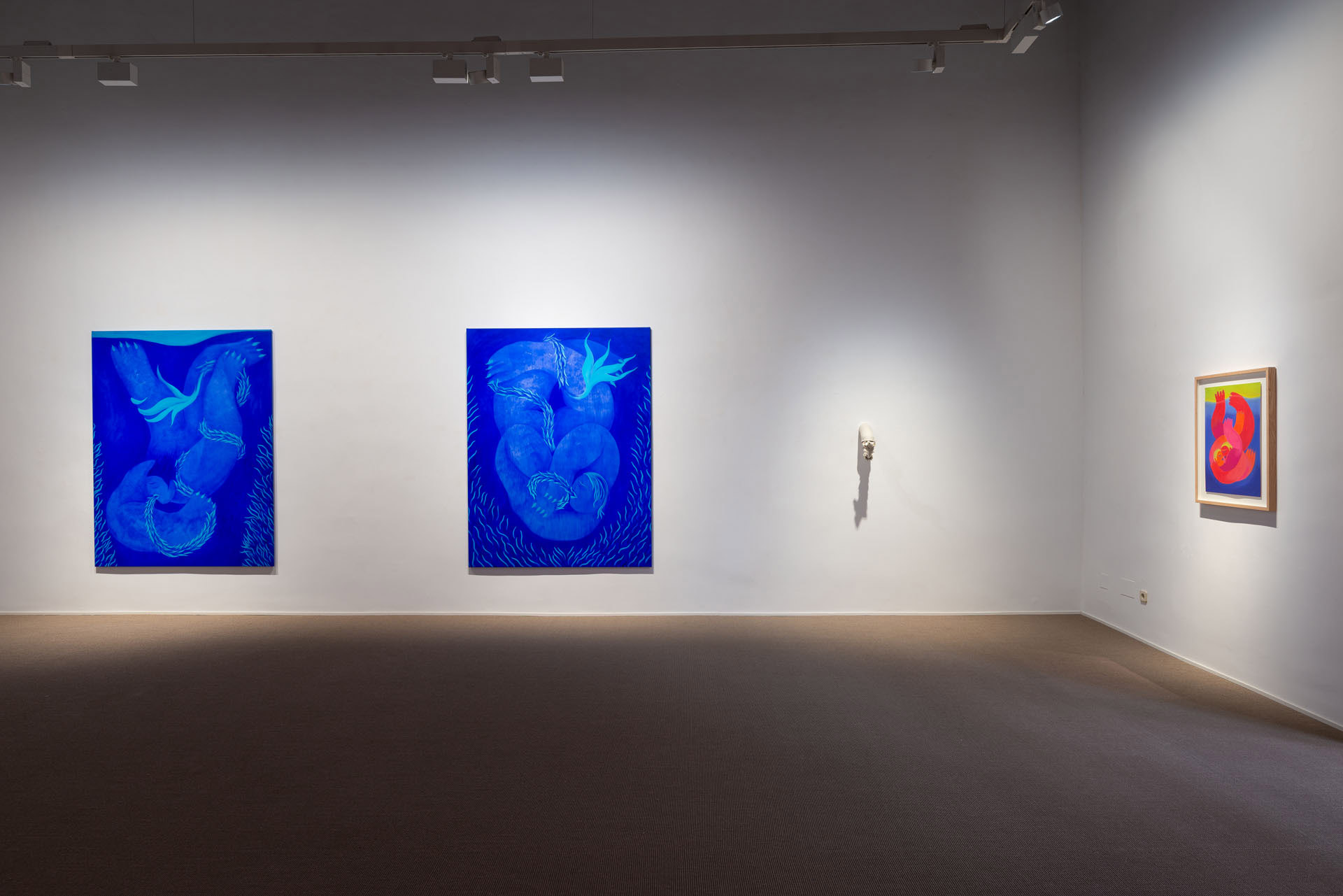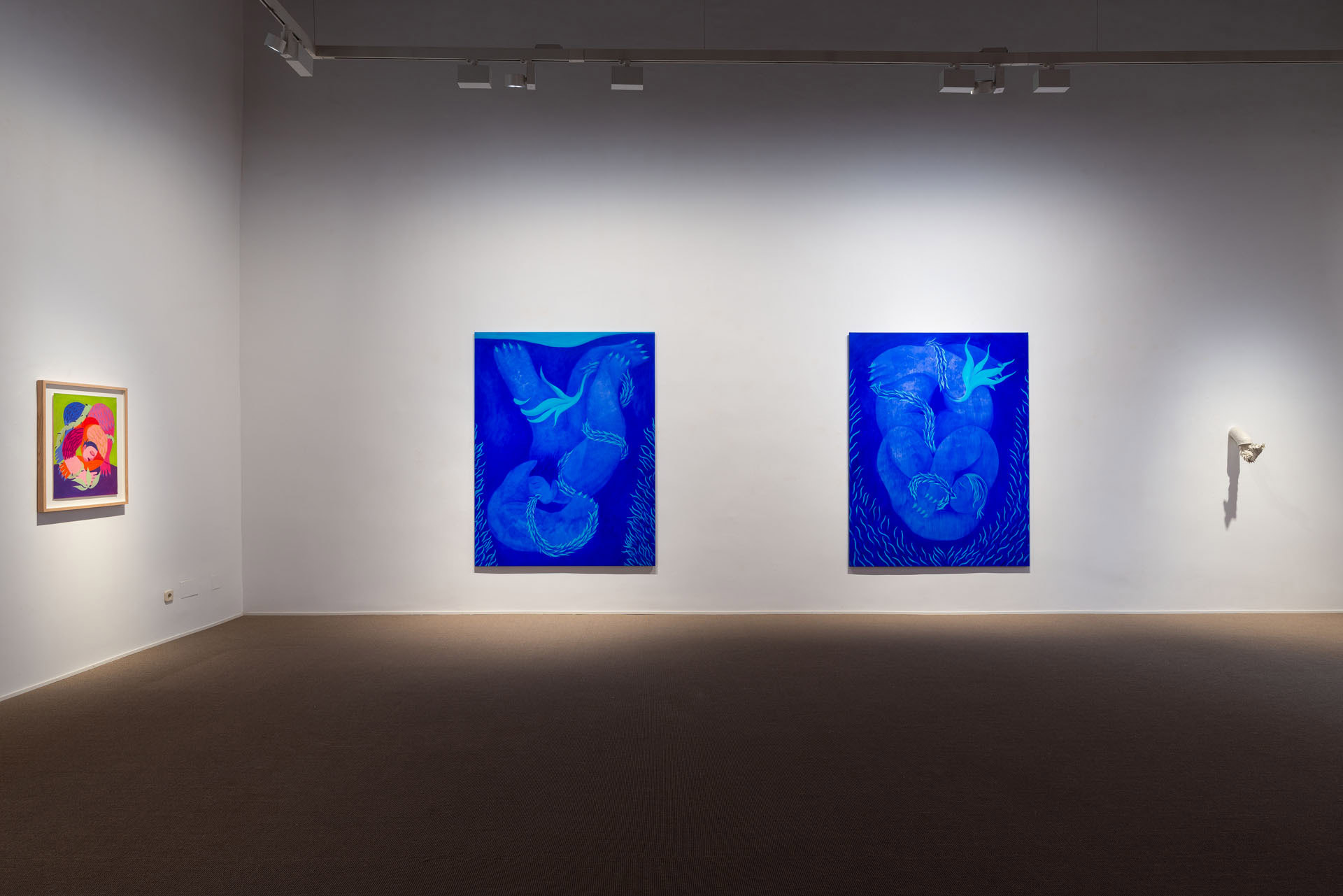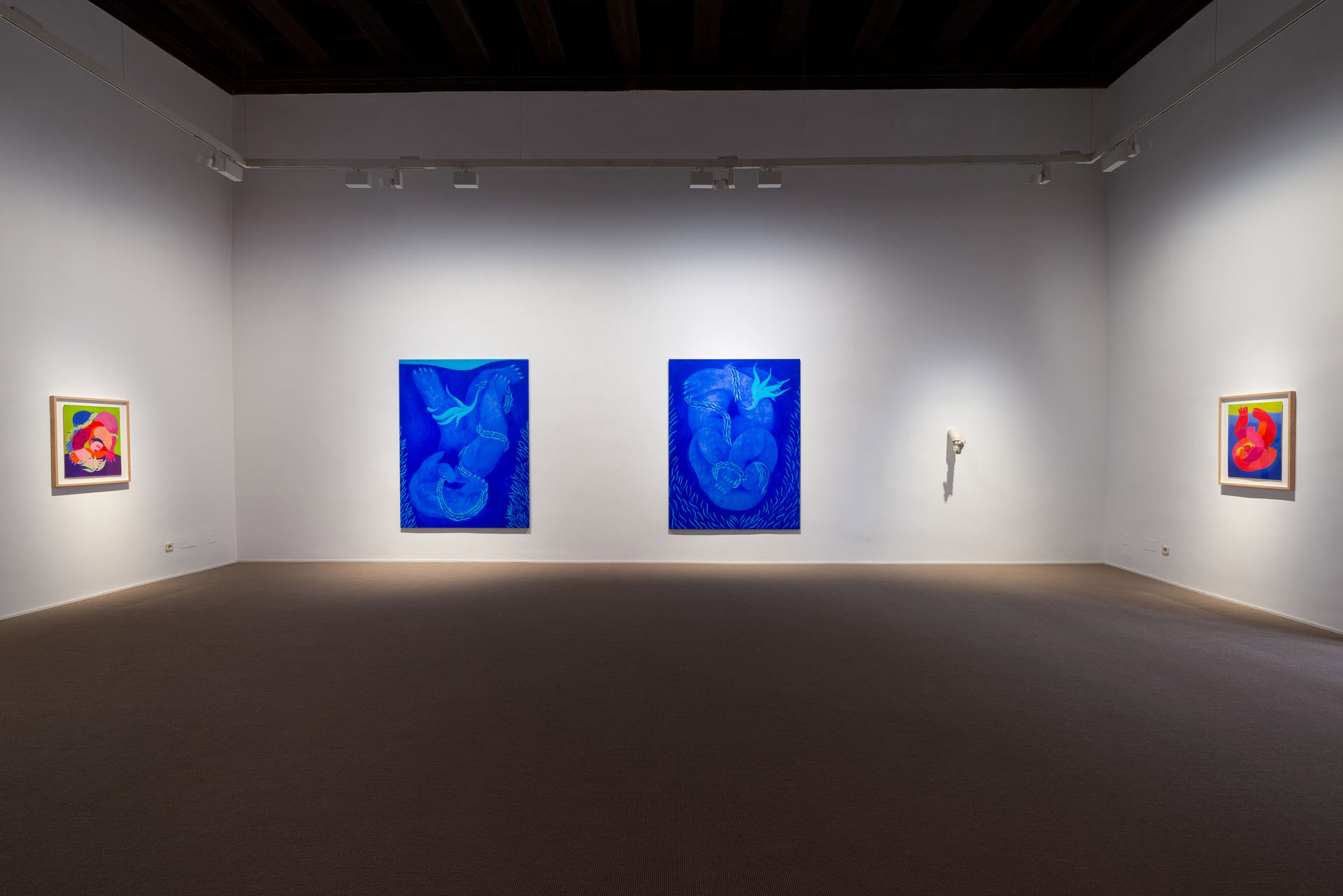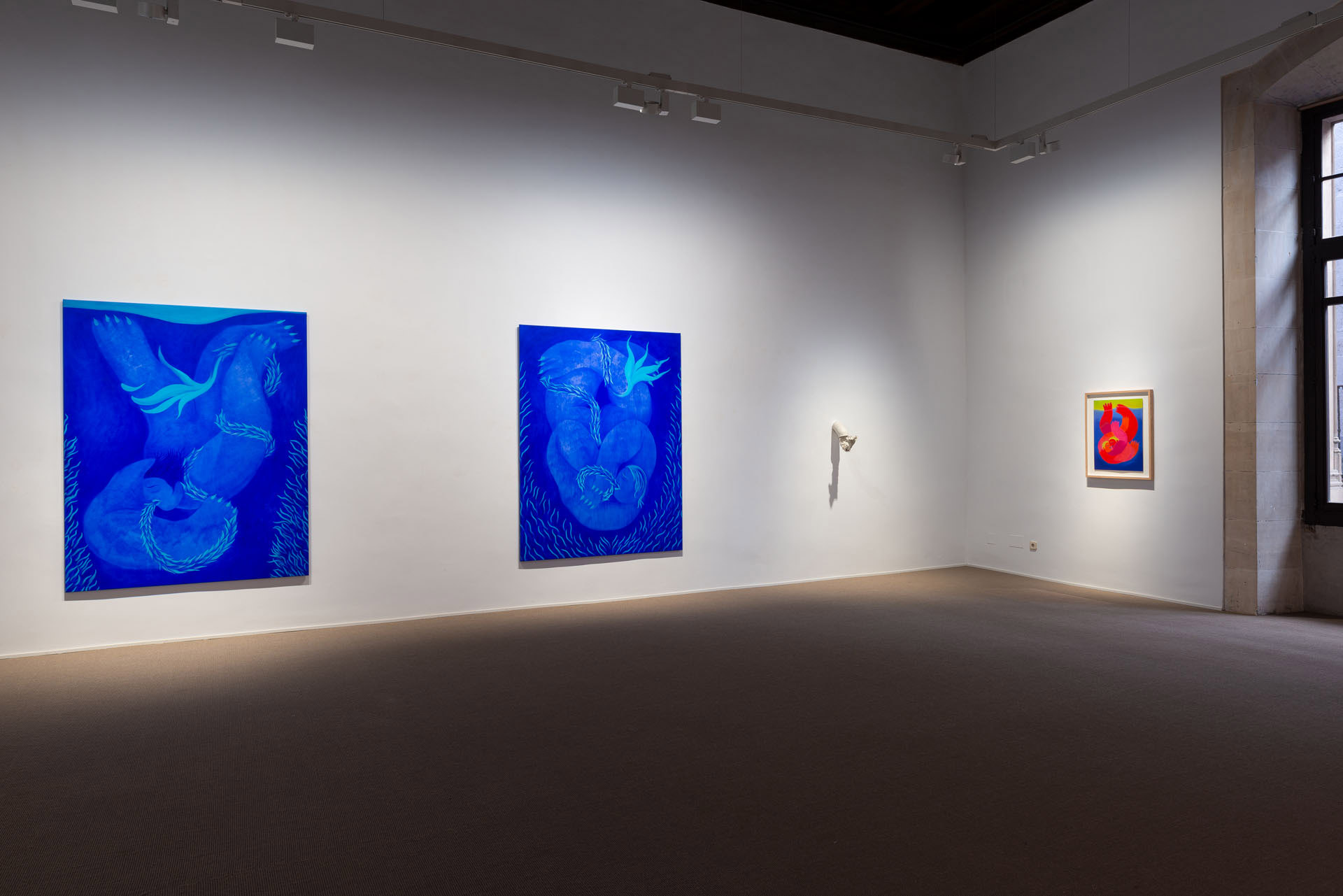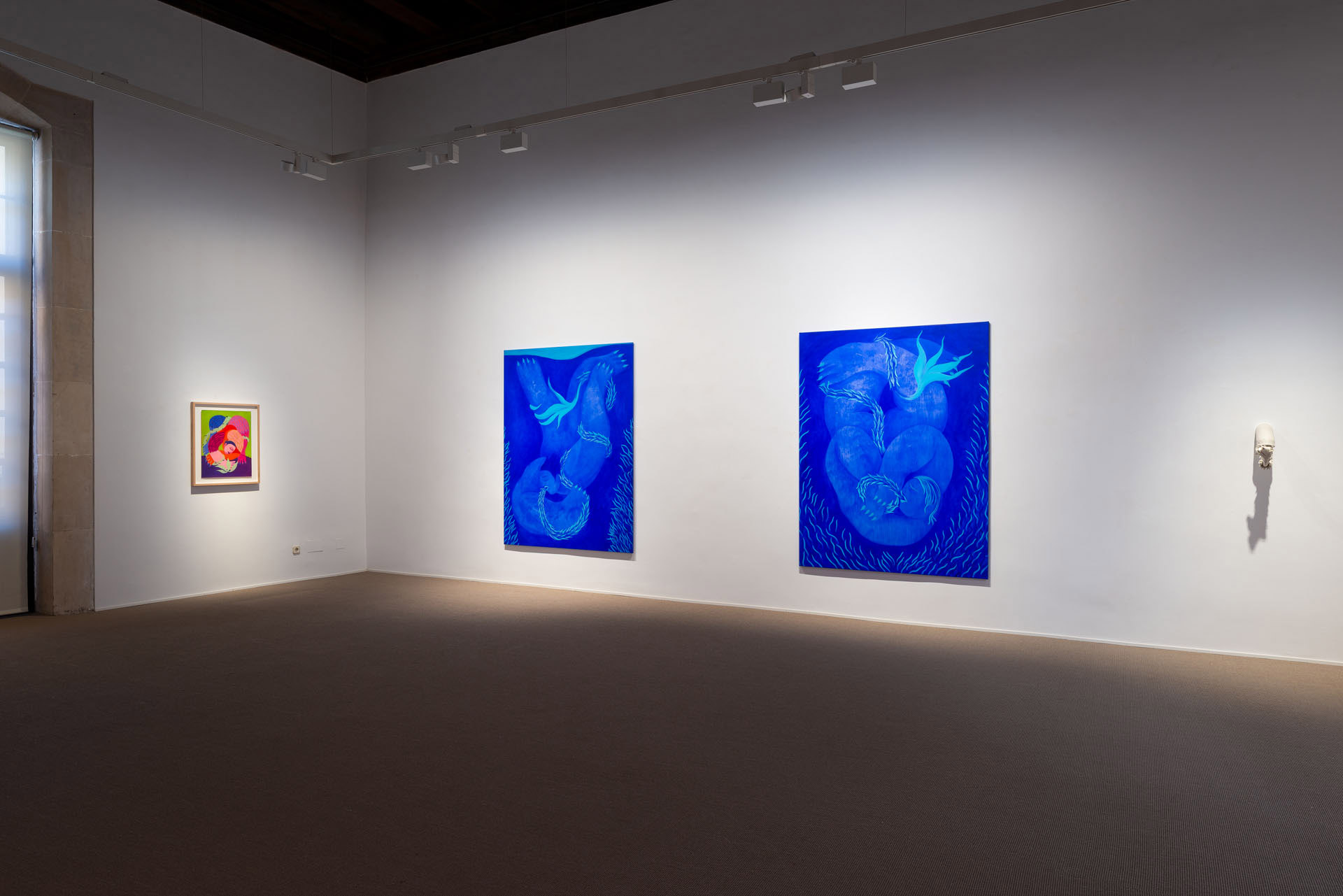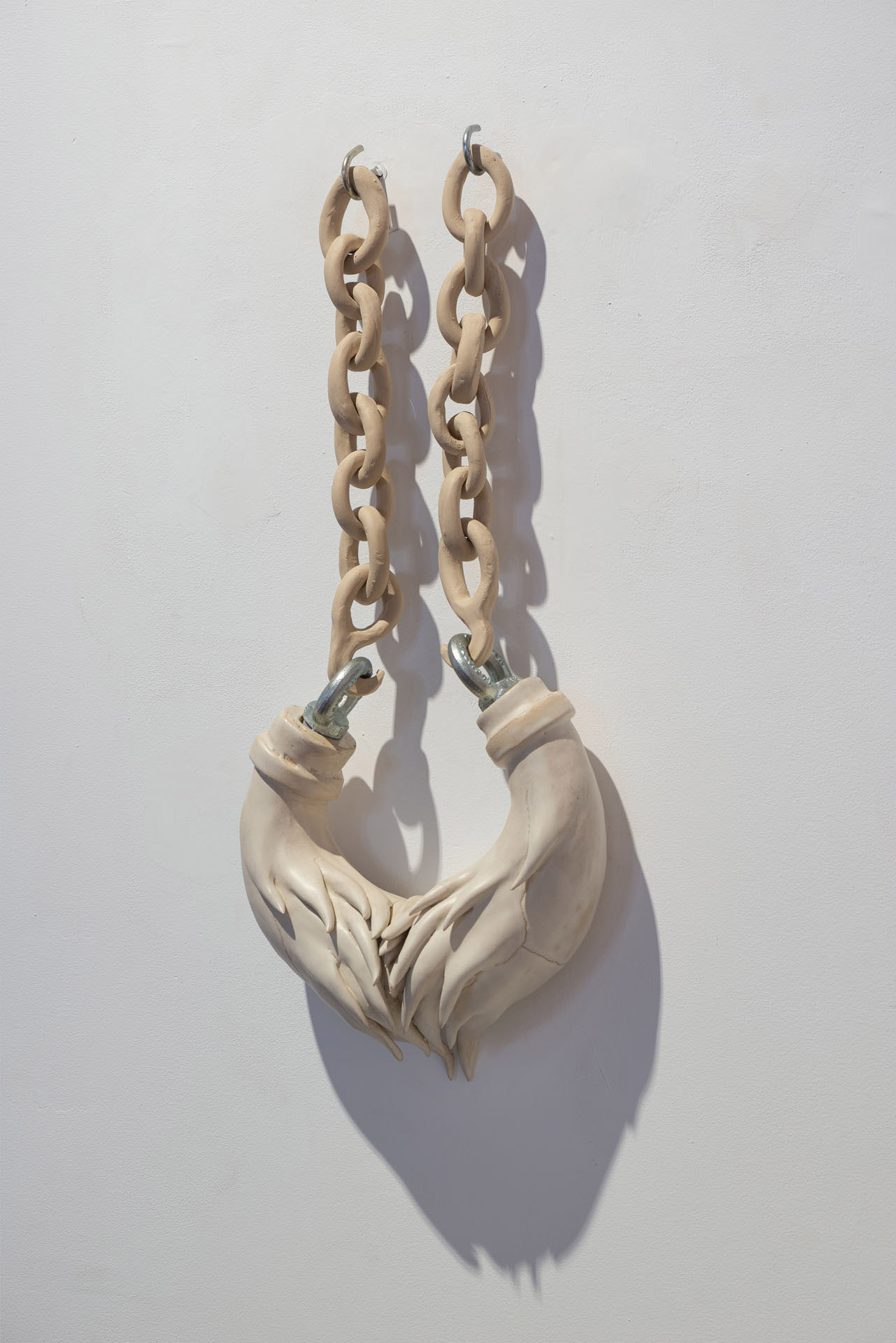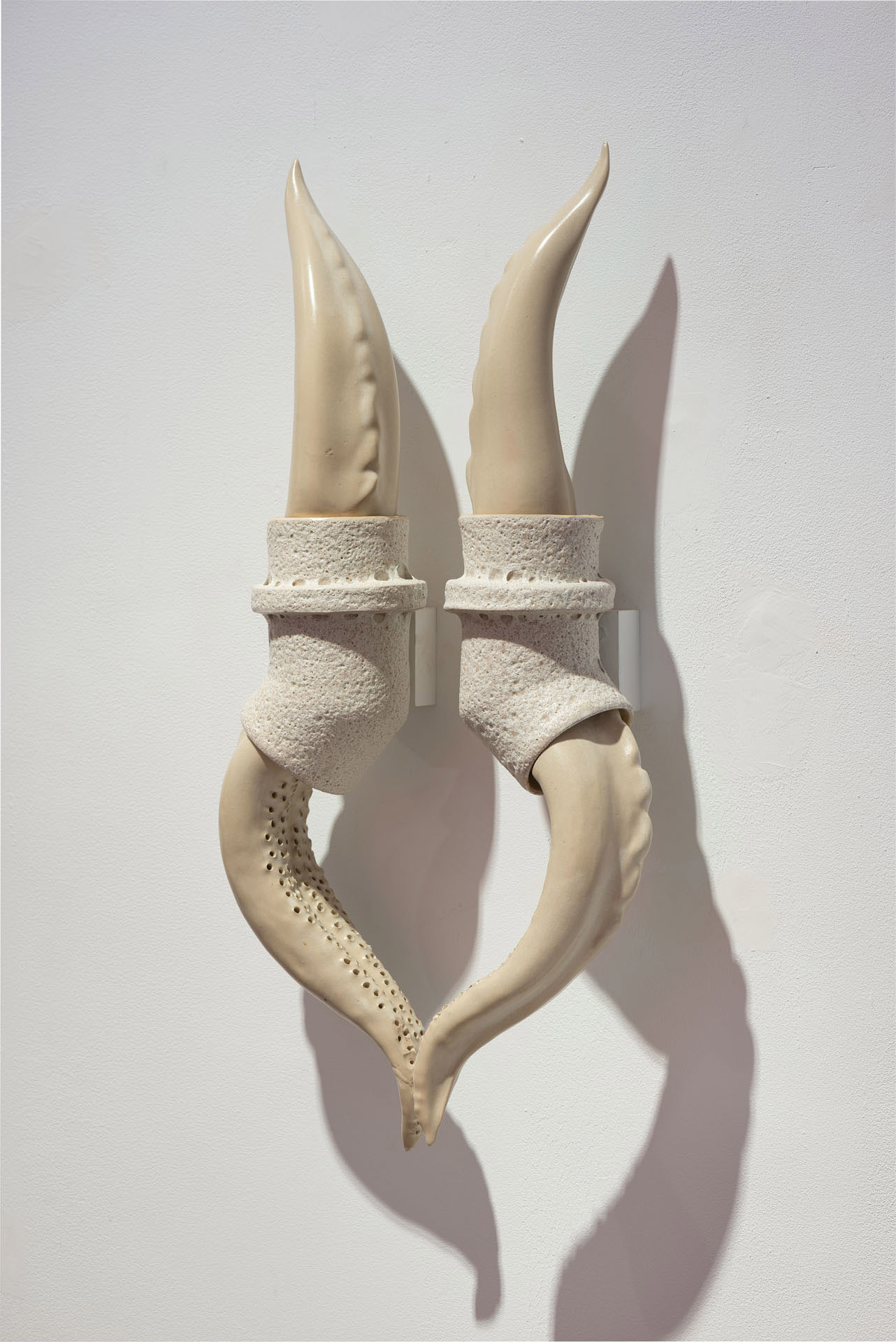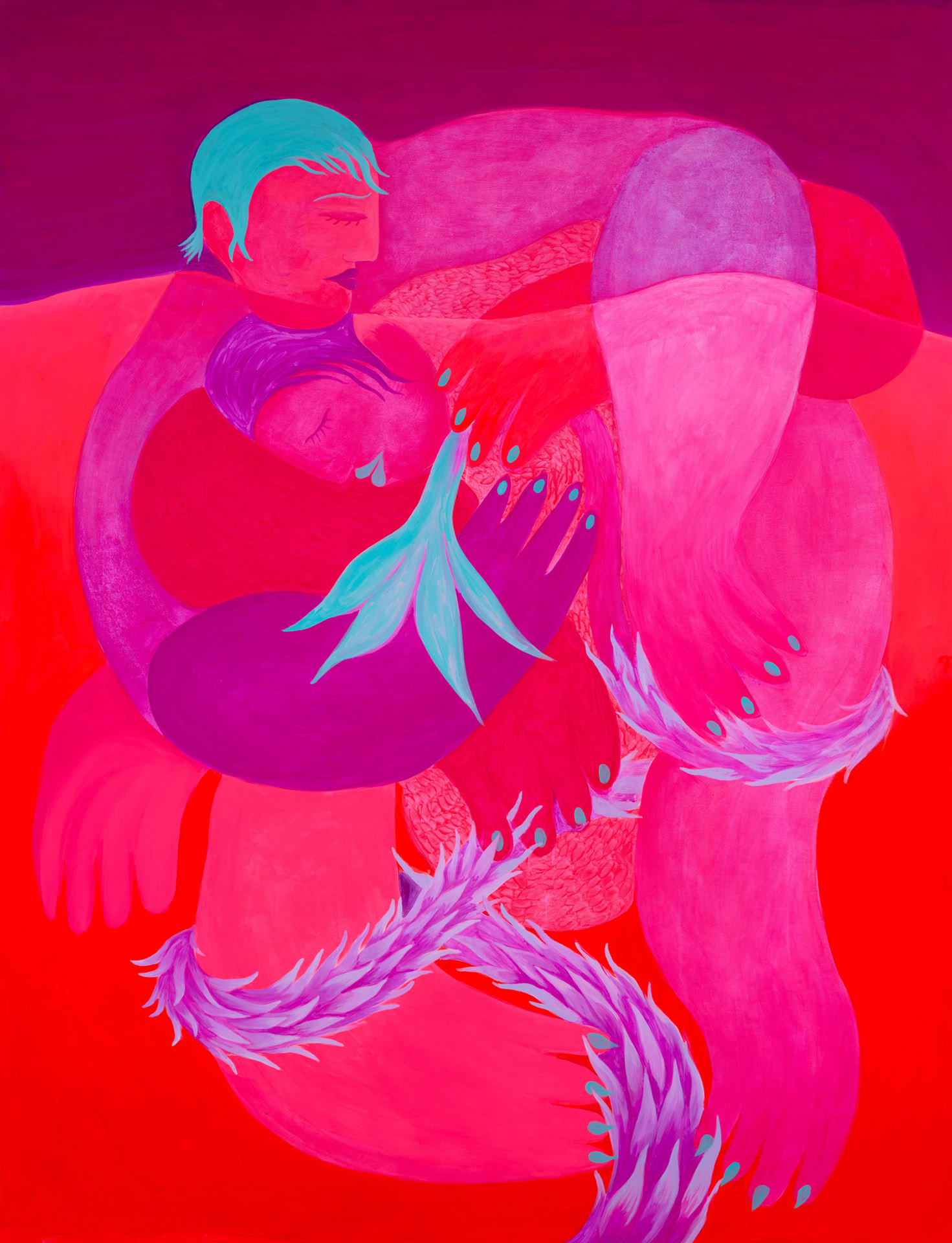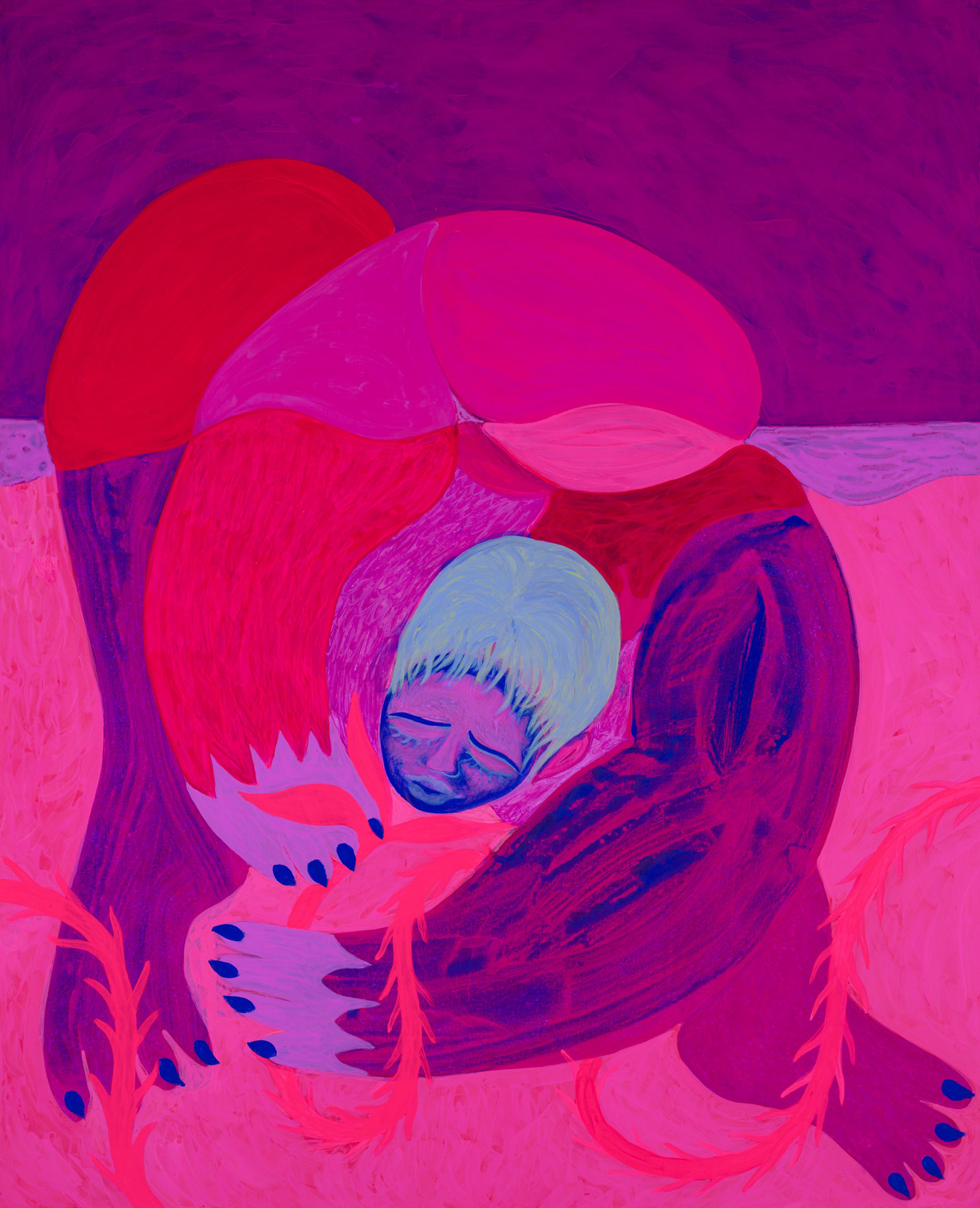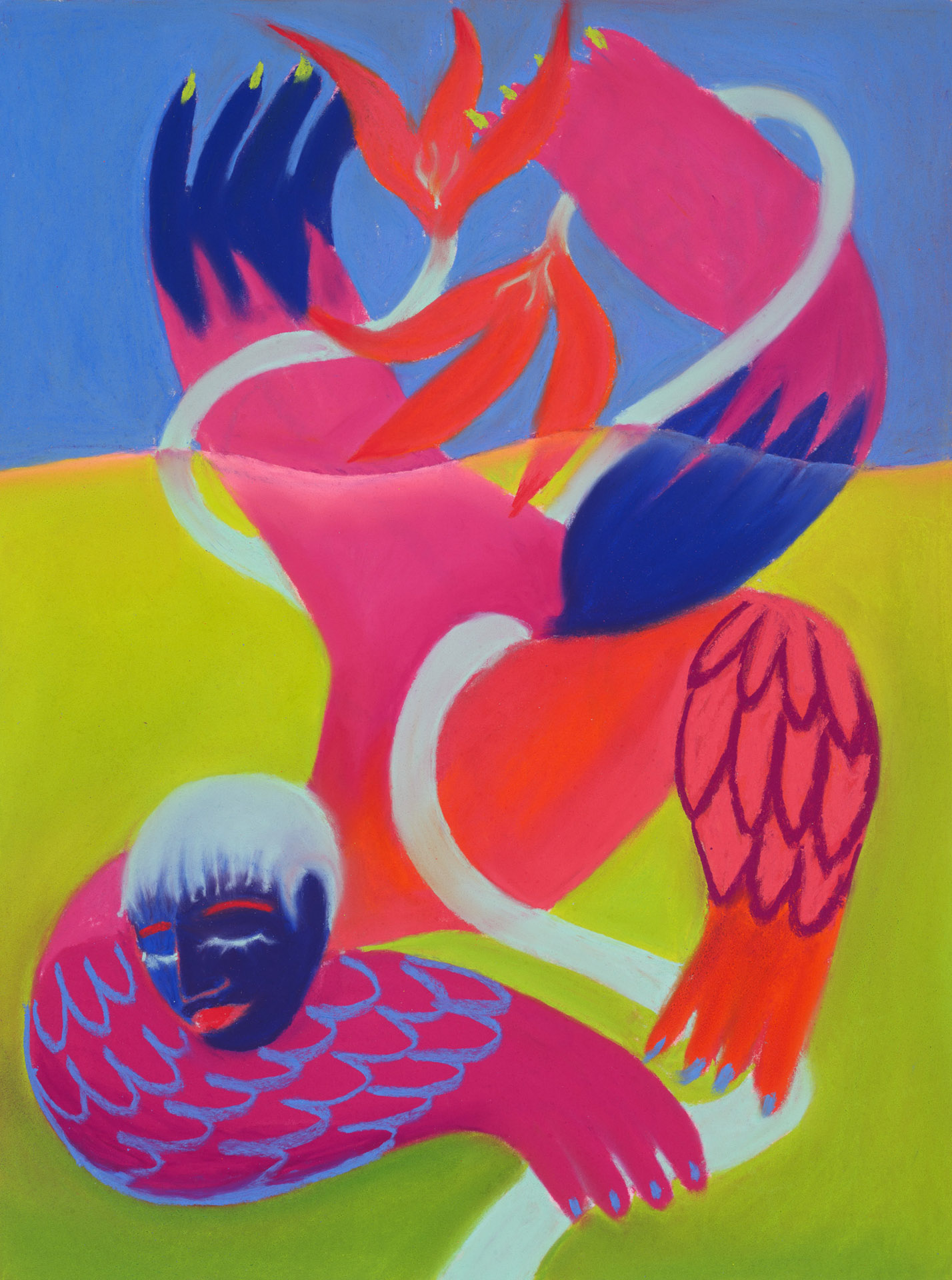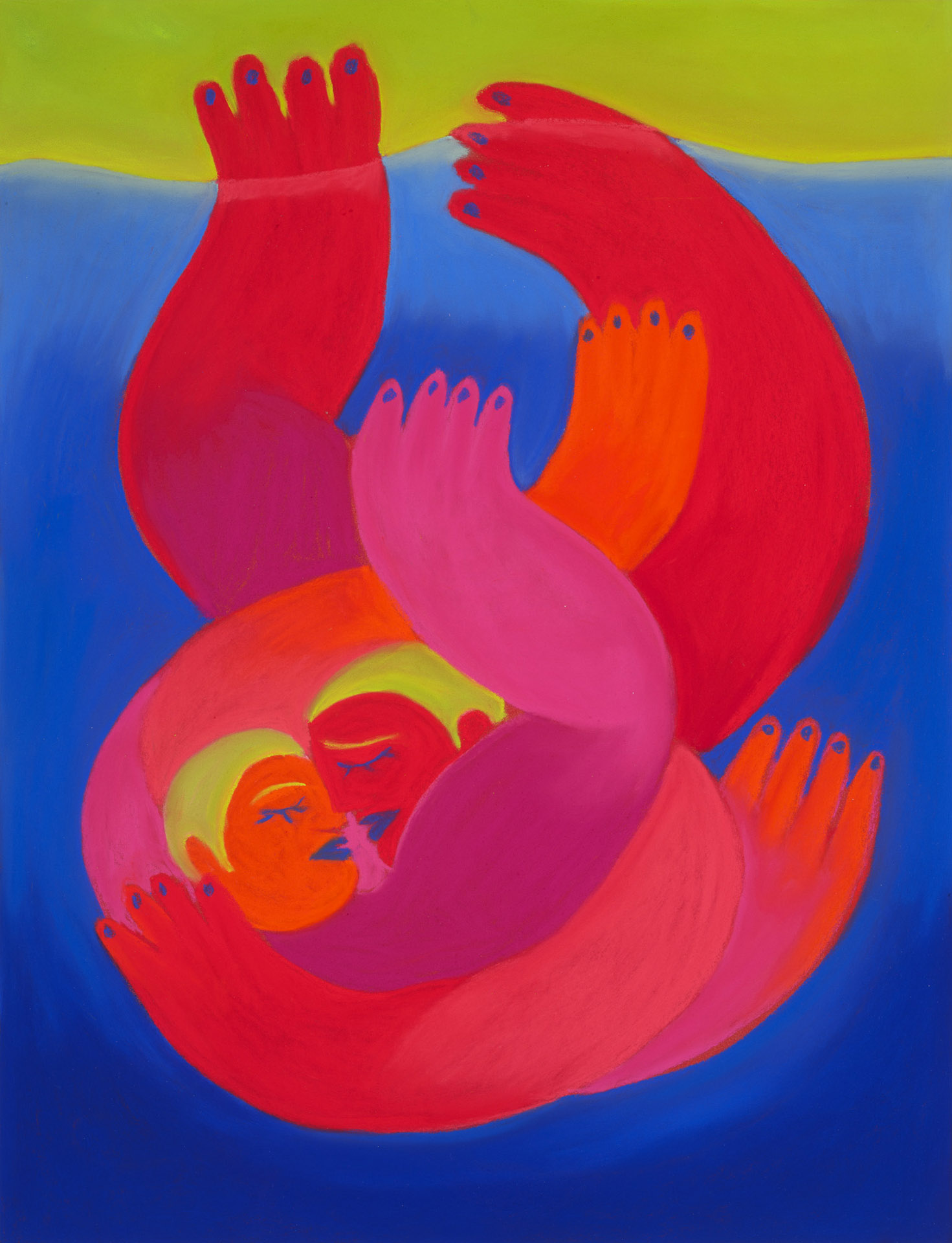Artist: Inês Zenha
Exhibition title: Everything that has been swallowed must return
Venue: Galería Pelaires, Mallorca, Spain
Date: September 23 – November 23, 2023
Photography: ©Roberto Ruiz, ©Grimalt de Blanch / all images copyright and courtesy of the artist and Galería Pelaires
In their solo show “Everything that has been swallowed must return”, the artist presents a new series of sculptures and paintings that reflect the need to confront and transform anger into acts of love and resistance.
Conversation between Julia Morandeira Arrizabalaga and Inês Zenha.
Dear Inês,
It’s good to meet again, in the ample space of this blank paper. We are both in the same city, Paris, but we are meeting through this writing. Writing about or with someone is always a gesture of intimacy, of getting under the skin of the practice; there is always something haptic and tactile, as much as conflictive and challenging. A tension and a caress.
Similarly, a dialectical friction is at play here in Everything That Has Been Swallowed Must Return.Some of the titles exhort orders and defense; yet, the show instills a sense of sensual and tranquil plenitude. You explore the coexistence of love and anger, care and confrontation, death and rebirth, pain and hope; you describe your work here as both as a sanctuary as much as a battlefield. These are not opposite, but mutually co-constructing and feeding each other.
A tone of intimacy and introspection silently embraces the works. You emphasize the importance of revisiting buried roots and repressed feelings, of carving out non-indulgent spaces of personal growth and self-expression, all encompassed by processes of collective acceptance and reflection through your work. The theme of water and its healing properties is central, with characters peacefully submerging themselves underwater and adopting amphibian traits. You also mention the significance of reclaiming one’s voice, especially when rooted in anger. I am interested in that, in anger and conflict as something not to be dismissed but embraced. Could you share more about the role of anger and conflict as a catalyst, both inside of your work and the space of self-reflection it triggers?
Your mention of “trigger” is particularly relevant because this show has been accompanying me through a time where I am learning to confront triggers and manage my anger in challenging situations. In many ways, my work constantly challenges me to be brutally honest with myself. Anger has always been a persistent undercurrent in my creative practice, often simmering in the background as a restless energy.
Within my artistic journey, I consciously embrace and confront aspects of myself that have long been suppressed or silenced. I work to transform my feelings of fear and anger into acts of love and resilience. My goal is to embody the vulnerability that my work seeks to withhold.
My anger assumes a dual nature, functioning both as a response developed to safeguard myself from past traumas and as a silent presence during moments of facing violence. The first type of anger, if arising in the presence of compassion and empathy, can transform into a healing force. It often acts as a protective shield for an underlying vulnerability, awaiting to be embraced instead. The second type of anger, the silenced anger, poses a more complex challenge. My commitment lies in not swallowing my tongue in situations of abuse and instead allowing anger to be the encouraging force when generating responses. I’ve come to realize that unlocked and transformed anger can lead to necessary conflicts.
Hence, my project revolves around the coexistence of love and anger. Through acts of love and acceptance, I’ve learned that anger serves as a vital warning sign, crucial for both personal growth and meaningful dialogue. The healing element in both my work and life lies in my unwavering determination to confront and transform these emotions within the intimate spaces of my being and to break the silence during moments of conflict.
Your sculptures take the form of tentacular, unruly terminations. Through these gestures you seek to reappropriate the monstrous and address the historical portrayal of dissident or marginalized people as monsters. Where does this come from? How do your sculptures challenge these stereotypes and redefine queerness as something natural and tender?
As a non-binary lesbian raised in a deeply Catholic culture, I was taught to believe that my body, my feelings, and my desires were unnatural, condemned through guilt and shame. It has been essential for me to reclaim these concepts and, more importantly, to recognize that my intimacy and body do not conform to the constraints imposed by these norms of domestication. Myself, intersectionally with other marginalized people in our society, have historically been portrayed as monsters, as threats, as anomalies in nature. However, when you delve into the intricacies of non-human life forms, you discover non-hegemonic, incredibly complex, and diverse systems and ecosystems. Nature is inherently diverse, embracing a queerness that our western society often fails to understand. I am far more interested in reclaiming my identity as both tender and monstrous. In the words of Ocean Vuong, ‘a monster is not such a terrible thing to be.’ Derived from the Latin root ‘monstrum,’ meaning a divine messenger of catastrophe, it was adapted by Old French to encompass animals of myriad origins, including centaurs, griffins, and satyrs. To be a monster is to be a hybrid signal, a lighthouse that serves as both refuge and warning simultaneously.
A red sculpture, Underneath Persephone’s Torso, stands out. You signal it delves into complex themes related to power, agency, and violence. Could you provide more insight into the symbolism and message behind this piece?
Derek Jarman once described the color red as static and unchanging in nature, saying that ‘Red protects itself. No color is as territorial. It stakes a claim, it is on the alert against the spectrum.’ Amidst the fluidity, ambiguity, malleability, and hybridity prevalent in all my artistic work and personal identity, a need for constancy persists. This constancy represents an imperative to assert ownership over my body and experiences.
The Persephone myth holds deep personal significance for me. Often, it’s been interpreted within two feminist perspectives: one portraying her as a victim of rape, the other as an empowered transition into womanhood. My intention is to emphasize and transcend this binary view, recognizing the multifaceted nature of her narrative and its relevance to contemporary issues.
The sculpture features an open torso and also functions as a sink or a fountain. On one side, it symbolizes the yearning for purification and liberation from the life that has confined her. On the other, it serves as a commentary on the collective responsibility we all bear for the figurative ‘blood of Persephone’ on our hands— how rape culture has been normalized through misogynistic rituals and the complicity that results from silence in the face of violence.
More-than-human fluid bodies populate the work, especially paintings and drawings. Algae sprouting from skin crevices, pawed hands, scaled arms, and peaceful faces are all entwined through the twists and swirls of an enamored embrace. Vivid colors punctuate this aquatic dance. What are the symbolisms you encapsulate here?
With my visual narratives, as you mentioned, my characters are more than human. They are aquatic embodiments of human emotional experiences. I have recently found the work of Astrida Neimanis, who describes water as entangling ‘our bodies in relations of gift, debt, theft, complicity, difference, and relation.’
In my paintings, I aim to convey a new narrative where characters submerge themselves underwater, as if delving into their innermost selves or exploring repressed emotions. They gently assist one another in learning how to breathe underwater, navigating an environment not naturally meant for human existence. These depictions also symbolize the importance of embracing vulnerability and relying on mutual support when traversing challenging emotional landscapes, drawing parallels to queer experiences and the need for community.
In my pieces titled Everything That Has Been Swallowed Must Return, my characters exhibit a sense of protection and courage as they dive deep down. They release a plant from their mouths, symbolizing both pain and hope, highlighting the significance of speaking difficult truths, even when the process is painful.
My choices of blue are connected to reclaiming vulnerability within masculine discourses. Pink is reclaimed too in its highest intensity, to symbolize the power in reclaiming fragility. The intense colors shift from pink, blue to yellow as a metaphor for queer joy and gender euphoria.
All these processes of symbiosis are connected to the motions of the cycle of digestion—of dissolving while nurturing, of biting and swallowing in order to eject and start anew. What questions do you feel you are facing now in your practice, and what future paths do they prefigure?
My practice has entered a transformative phase over these past two years. It has played a pivotal role in my journey to reclaim my body and reaffirm my identity. Simultaneously, it has helped me to question my role as an artist. I believe that my practice embodies a profound sense of intimacy, and I consider it essential to occupy this creative space in such a manner.
These artworks revisit long-buried roots and encourage individuals to vulnerably revisit themselves and their intimate wounds. Yet, I am also interested in the redefinition of love and the importance of diverse modes of existence within and outside our corporeal forms. I am learning and drawing inspiration from non-human forms and constructing narratives that not only shed light onto problems of resistance and societal corsets, but that also celebrate queer experiences and its transformative nature.
I do not know which form my work will take. I just hope it can help to bring awareness to our forms of existing inside our bodies and with others, including other living forms. Whilst remembering what water teaches us about empathy and compassion.

